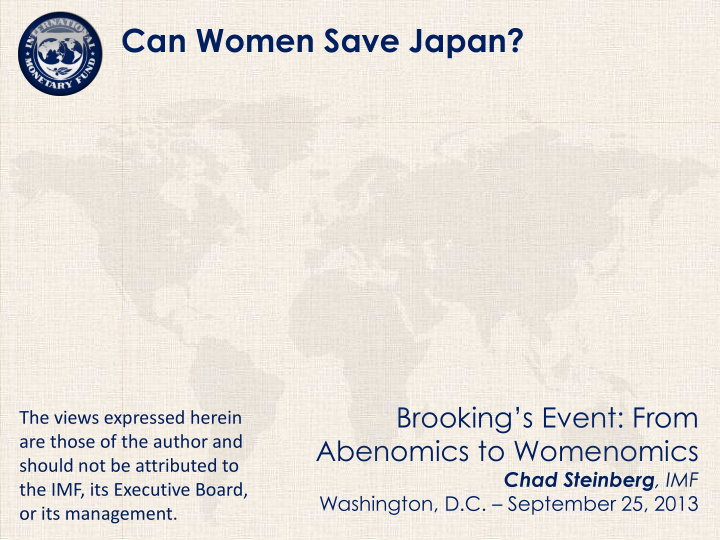



Can Women Save Japan? Brooking’s Event: From The views expressed herein are those of the author and Abenomics to Womenomics should not be attributed to Chad Steinberg , IMF the IMF, its Executive Board, Washington, D.C. – September 25, 2013 or its management.
Japan’s demographic change is unprecedented Demographic Change (1980-2040) Working-age Population (1950- 2050) (Index, 1950=100) (Million people) 100 250 250 Forecast 90 1980 DEU 80 FRA 200 200 2040 JPN 70 GBR 60 150 150 Age 50 40 30 100 100 20 10 50 50 0 1950 1960 1970 1980 1990 2000 2010 2020 2030 2040 2050 1.5 -0.5 -2.5 Source: MIC and IPSS Source: UN Can Women Save Japan? MOTIVATION
… but Japan has a highly-educated secret weapon: an army of housewives Can Women Save Japan? MOTIVATION
Raising female labor participation (FLP) could increase GDP by as much as 8 percent Difference by Gender in Prime-age Real GDP: Policy Scenario with Labor Participation (In % pts., 2009) Higher FLP (In trillion yen) 35 35 660 660 Forecast 30 30 620 620 Baseline 25 25 With G7 FLP ratio 580 580 20 20 With Northern Europe FLP ratio 15 15 540 540 28.5 25.0 10 10 500 500 14.1 13.1 12.2 5 5 5.7 460 460 0 0 420 420 1990 1995 2000 2005 2010 2015 2020 2025 2030 Source: WEO and IMF staff estimates. Source: OECD, and IMF staff estimates Can Women Save Japan? MOTIVATION
Increases in FLP are associated with a large demographic shift FLP Distribution Across 22 Countries Demographic Variables and FLP 6 Changes (1970-2007) (Index, 1970=100) 160 40 1985 5 150 50 2005 Number of Countries 140 60 4 130 70 3 120 80 FLP 110 90 2 Education 100 100 1 Marriage rate (RHS) 90 110 Japan Japan 1985 Number of children per 2005 0 woman (RHS) 80 120 20 40 60 80 100 1970 1975 1980 1985 1990 1995 2000 2005 FLP Source: OECD, UN, and IMF staff estimates Source: OECD Can Women Save Japan? CROSS-COUNTRY EVIDENCE
...with policies becoming more important as demographics converge FLP vs. Children per Woman (2008) FLP vs. Children per Woman (1980) 90 90 SWE SWE FIN 80 DNK 85 FIN NOR CHE FRA 70 PRT CAN NLD NOR AUT 80 DEU USA FLP FLP FRA 60 GBR CAN NZL DEU JPN 75 USA PRT AUS AUS 50 ESP LUX IRL 70 40 JPN ITA GRC NLD 30 65 ESP ITA 0.5 0.6 0.7 0.8 0.9 1 0.4 0.45 0.5 0.55 0.6 0.65 Children per Woman Children per Woman Source: OECD Source: OECD Can Women Save Japan? CROSS-COUNTRY EVIDENCE
…but there are no policy silver bullets Effects are relatively small Impact of 1 S.D. Wage gaps and childcare are Wage gap -0.27 good predictors of cross-country differences Log (Family allowance) 0.14 Log (Leave) 0.36 Women have a strong preference Log (Child benefits) -0.13 for part-time work Part-time incidence -0.19 Leave policies must be generous Log (Childcare per child) -0.03 to be effective Log (Tax wedge) -0.73 Source: Fund staff calculations Tax incentive and cash payments work best at lower incomes Can Women Save Japan? CROSS-COUNTRY EVIDENCE
Hurdle 1: Employment and Promotion Policies Female Sogoshoku Workers in 2000 Female Managers (2009) and 2010 (In percent) (As percent of total) 60 60 50 2000 40 40 40 2010 30 20 20 20 10 0 0 Share of Total Share of Newly Share of 0 Sogoshoku Hired Companies Sogoshoku with Equal USA FRA DEU GBR DNK JPN KOR Promotion Source: MHLW and IMF staff estimates Source: UNDP Can Women Save Japan? JAPAN-SPECIFIC HURDLES
Hurdle 2: Balancing Family Responsibilities with Work Female Labor Participation Rate by Public Expenditure on Child Age Group (2009) (In percent) Support (2005) (In percent of GDP) 1.2 1.2 100 100 Childcare spending 1.0 1.0 80 80 as a % of GDP 0.8 0.8 Pre-primary 0.4 60 60 spending as a % of 0.6 0.6 GDP DEU 40 40 0.2 JPN 0.4 0.4 0.6 DNK 0.1 20 20 0.3 0.2 0.3 0.2 0.4 USA 0.1 0.2 0.1 0.1 0.1 0.0 0.0 0 0 15-19 20-24 25-29 30-34 35-39 40-44 45-49 50-54 55-59 60-64 65-69 SWE GBR DEU USA JPN KOR Source: OECD Source: OECD Can Women Save Japan? JAPAN-SPECIFIC HURDLES
Further reading “Can Women Save Japan?” IMF Working Paper No. 12/248 “Women, Work, and the Economy: Macroeconomic Gains from Gender Equity,” IMF Staff Discussion Note No. 13/10 Can Women Save Japan?
Recommend
More recommend